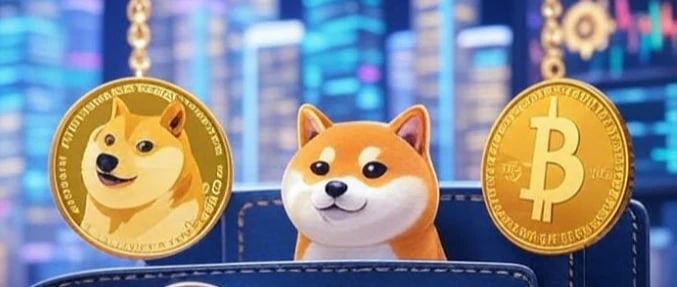
This website uses cookies
We use Cookies to ensure better performance, recognize your repeat visits and preferences, as well as to measure the effectiveness of campaigns and analyze traffic. For these reasons, we may share your site usage data with our analytics partners. Please, view our Cookie Policy to learn more about Cookies. By clicking «Allow all cookies», you consent to the use of ALL Cookies unless you disable them at any time.
The cryptocurrency landscape has witnessed a remarkable surge in two seemingly distinct phenomena: memecoins and decentralized finance (DeFi). Memecoins like Dogecoin and Shiba Inu began as lighthearted, meme-driven tokens, capturing the internet’s imagination with their playful branding and community spirit. Dogecoin, launched in 2013 as a satirical take on Bitcoin, gained mainstream fame through viral social media campaigns and endorsements from figures like Elon Musk, peaking at a market cap of over $88 billion in 2021. Shiba Inu, dubbed the “Dogecoin killer,” followed suit, amassing a fervent following and introducing its ecosystem, including a decentralized exchange called ShibaSwap. Meanwhile, DeFi has emerged as a revolutionary force in finance, leveraging blockchain technology to create decentralized financial systems that operate without traditional intermediaries like banks. By 2025, the total value locked (TVL) in DeFi protocols has grown to over $150 billion, with platforms like Uniswap and Aave offering services such as lending, borrowing, and trading in a trustless environment. The growing popularity of memecoins and DeFi highlights a shared ethos of decentralization and community empowerment, setting the stage for their integration. When memecoins, with their massive user bases and cultural momentum, intersect with DeFi’s innovative financial infrastructure, the potential to reshape decentralized finance becomes evident.
What Are Memecoins and DeFi?
Let’s break it down. Memecoins are cryptocurrencies that start as a bit of a joke, often inspired by internet memes or viral trends. Think Dogecoin, which kicked off in 2013 with a Shiba Inu dog as its mascot, poking fun at the crypto craze. Or Shiba Inu, another dog-themed coin that came later, riding the wave of Dogecoin’s success. These tokens are community-driven - built and hyped by groups of fans on platforms like X or Reddit. They’re not about fancy tech or solving big problems; their appeal is cultural, tapping into humor and a sense of belonging. People buy in because it’s fun. After all, their favorite influencer mentioned it, or because they hope to catch the next big price spike. But beneath the memes, they’re still tokens on blockchains like Bitcoin’s or Ethereum’s, with real market value and trading volume.
DeFi, on the other hand, is a more serious player. Short for decentralized finance, it’s a system of financial tools built on blockchain technology that cuts out middlemen like banks or brokers. Instead of trusting a bank to hold your money or process a loan, DeFi uses smart contracts - self-running programs on blockchains like Ethereum - to handle everything. Want to lend money and earn interest? You can stake your crypto in a DeFi protocol like Aave. Want to trade without a centralized exchange? Platforms like Uniswap let you swap tokens directly. It’s all about transparency and control: you manage your funds, and the blockchain ensures the rules are followed. By 2025, DeFi has exploded, managing billions in assets and offering everything from loans to insurance, all without a traditional financial institution in sight. Together, memecoins and DeFi represent two sides of crypto’s potential - one playful and cultural, the other practical and transformative.
How Memecoins Integrate with DeFi Platforms
So, how do memecoins fit into the DeFi world? It’s pretty straightforward once you dig into the mechanics. DeFi platforms are built to work with all kinds of tokens, and memecoins like Dogecoin or Shiba Inu are no exception - they’re just another asset on the blockchain. Let’s look at the main ways they plug into DeFi.
First up, liquidity pools. These are the backbone of decentralized exchanges (DEXs) like Uniswap or PancakeSwap. A liquidity pool is a big pot of tokens that people can trade against. Say you’ve got some Shiba Inu tokens. You can pair them with another token, like ETH, and add them to a pool on Uniswap. In return, you get a cut of the trading fees when others use that pool to swap tokens. Memecoins are perfect for this because they often have huge communities willing to provide liquidity, which makes trading smoother and attracts more users.
Then there’s staking. Some DeFi platforms let you lock up your memecoins to earn rewards. For example, Shiba Inu has its ecosystem with ShibaSwap, where you can stake your SHIB tokens to earn extra tokens like BONE. It’s like putting your money in a savings account, but instead of interest, you get more crypto. This gives memecoin holders a way to make their tokens work for them instead of just sitting in a wallet.
Yield farming takes it a step further. This is when you move your tokens around different DeFi protocols to chase the best returns. Let’s say you stake your Dogecoin in a pool on PancakeSwap to earn CAKE tokens, then take those CAKE tokens and stake them somewhere else for even more rewards. It’s a bit like playing a game of hot potato with your crypto, but it can be profitable if you know what you’re doing. Memecoins, with their low entry price, make yield farming accessible to more people.
Finally, DEXs themselves are a big part of the integration. Platforms like Uniswap or PancakeSwap let you trade memecoins directly, without a middleman. You can swap your ETH for Dogecoin in seconds, and the whole process is handled by smart contracts. This is huge for memecoins because it gives them a marketplace where anyone can jump in - no need for a big exchange like Coinbase to list them. It’s all decentralized, which fits the memecoin vibe perfectly. That’s how memecoins are weaving into DeFi - through pools, staking, farming, and trading, they’re becoming part of the broader financial ecosystem.
Benefits of Memecoin-DeFi Integration
Bringing memecoins into the DeFi space has some real upsides that are worth unpacking. It’s not just about the hype - there are practical benefits that make this combo a game-changer for crypto.
First off, increased liquidity. Memecoins like Dogecoin or Shiba Inu have massive communities, and when they jump into DeFi platforms, they bring a ton of tokens with them. By adding their memecoins to liquidity pools on places like Uniswap or PancakeSwap, these users help create deeper pools for trading. More liquidity means less price slippage when you trade, so it’s easier for everyone to buy or sell without prices going haywire. It’s a win for the whole ecosystem - memecoins get more trading action, and DeFi platforms get more volume.
Then there’s broader user adoption. Memecoins have a knack for pulling in people who might not otherwise touch crypto. They’re cheap, fun, and easy to understand - someone might buy Shiba Inu because they like the dog meme, not because they care about blockchain tech. Once they’re in, DeFi gives them a reason to stick around. They can stake their tokens, earn rewards, or trade on a DEX, which introduces them to the wider world of decentralized finance. It’s like a gateway drug for crypto newbies, and it helps DeFi grow by bringing in a fresh crowd that might have been too intimidated to start with something like Ethereum.
Another big plus is innovative financial products. Memecoins in DeFi open the door to new ideas that wouldn’t exist otherwise. For example, Shiba Inu’s ecosystem has its tokens like BONE and LEASH, which you can earn by staking SHIB on ShibaSwap. That’s a new kind of reward system built around a memecoin. Or take yield farming - someone might create a farm where you stake Dogecoin to earn a mix of other tokens, blending memecoin hype with DeFi mechanics. These products keep things exciting and give users more ways to play with their crypto, which keeps the space evolving.
Lastly, enhanced accessibility for retail investors. Memecoins are dirt cheap compared to something like Bitcoin - think fractions of a cent per token. That low price makes them an easy entry point for regular folks who can’t afford to drop thousands on a single coin. Pair that with DeFi, and suddenly those same people can do more with their money. They can stake their $50 worth of Shiba Inu on a platform like Aave, earn a bit of interest, or swap it for another token on a DEX - all without a bank or a big exchange. It levels the playing field, giving small-time investors tools that used to be out of reach. That’s the kind of empowerment that makes memecoin-DeFi integration so promising.
Challenges and Risks of Combining Memecoins with DeFi
Mixing memecoins with DeFi sounds exciting, but it’s not all smooth sailing. There are some serious challenges and risks that can trip things up if you’re not careful.
First, high volatility. Memecoins like Dogecoin or Shiba Inu are notorious for wild price swings. One tweet from someone like Elon Musk can send Dogecoin up 50% or crash it just as fast. That kind of unpredictability is a headache in DeFi, where you’re often locking up tokens in liquidity pools or staking them for rewards. If the price tanks while your tokens are tied up, you could lose a lot of value before you even blink. It’s a gamble, and not everyone’s ready for that rollercoaster.
Then there’s the risk of rug pulls. A rug pull is when the creators of a project hype up a memecoin, get people to pour money into it, like into a DeFi liquidity pool, and then disappear with the funds. It’s happened plenty of times with memecoins because they’re so easy to spin up. Someone launches a new “DogeKiller” token, promises big returns on a DeFi platform, and then pulls the rug, leaving investors with nothing. Since DeFi is decentralized, there’s often no one to hold accountable, and your money’s just gone.
Regulatory uncertainty is another big issue. Governments are still figuring out how to handle crypto, and memecoins in DeFi make things even messier. Are they securities? Are they currencies? Nobody’s sure, and that gray area can lead to trouble. If a country cracks down, like the U.S. SEC going after unregistered DeFi platforms, you might find your memecoin staking pool shut down or your funds frozen. Plus, some memecoins have been tied to shady practices, which could drag DeFi into the crosshairs of regulators. It’s a murky space, and the rules could change fast.
Finally, smart contract vulnerabilities in DeFi protocols are a real concern. DeFi runs on smart contracts - code that handles everything automatically. But code can have bugs. If a hacker finds a weak spot in a DeFi platform where you’ve staked your Shiba Inu, they can drain the whole pool. It’s happened before: in 2021, a platform called Poly Network got hacked for $600 million, and plenty of smaller DeFi projects have been hit since. Memecoins don’t add to the problem directly, but their popularity makes them a juicy target for scammers exploiting DeFi flaws. If you’re jumping into this space, you’ve got to know the tech isn’t foolproof.
So yeah, while memecoins and DeFi can work well together, these pitfalls - volatility, scams, unclear laws, and buggy contracts - mean you’ve got to tread carefully. It’s not a free ride.
Future Prospects and Conclusion
Looking ahead, memecoins in DeFi have a lot of potential to grow, but it’s going to be a bumpy ride. Right now, tokens like Dogecoin and Shiba Inu are mostly seen as fun, speculative plays, but their role in DeFi could evolve into something bigger. As DeFi platforms get more user-friendly, we might see memecoins becoming a go-to for everyday people who want to dip their toes into decentralized finance. Imagine someone using Shiba Inu to take out a small loan on Aave or staking Dogecoin to earn steady interest - things that feel out of reach with traditional banks. Over the next five to ten years, I think memecoins could help DeFi go mainstream by bringing in millions of new users who were drawn in by the memes but stay for the financial tools. We’re already seeing hints of this with ShibaSwap and other memecoin-driven projects that blend community hype with real DeFi utility.
The impact on mainstream finance could be huge. If memecoins and DeFi keep growing together, they might force traditional finance to adapt. Banks and big exchanges could start offering their decentralized products to compete, like tokenized savings accounts or hybrid trading platforms that mix the best of DeFi with old-school stability. Memecoins, with their low cost and massive reach, could also push financial inclusion, especially in places where banking is hard to access. Someone in a developing country might use Dogecoin to join a DeFi lending pool and start earning, no bank account needed. But for this to happen, the space needs to mature - less wild price swings, better security, and clearer rules from governments.
The benefits of memecoin-DeFi integration - like more liquidity, wider access, and new financial products - are real, but so are the risks. Volatility can wipe out savings, rug pulls can scam users, and buggy smart contracts can lead to hacks. Developers, communities, and even regulators need to step up. That means building safer protocols, educating users about the risks, and creating standards that keep the space fair without killing its decentralized spirit. If we get this right, memecoins and DeFi could reshape finance for the better - more open, more inclusive, and more empowering for regular people.
At Technorely, we’re blockchain experts and have been working in this space for years. If you need blockchain development in any direction - whether it’s DeFi, memecoins, or something else - reach out to us through our contact form. We’d love to help bring your ideas to life.




